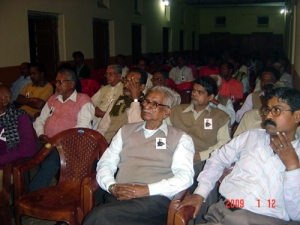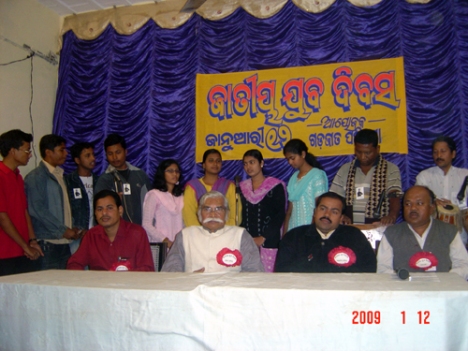A blatant ban on active practice of religion is most urgent as otherwise the country can never be saved from the worst of unrest, warned eminent scribe and social activist Subhas Chandra Pattanayak at Athgarh on January 12 while addressing as the Chief Guest a congregation of politicians, academicians, advocates, students and youth on occasion of the National Youth Day dedicated to Swami Vivekanand.
Strongly disapproving the way religious revivalists have endangered Indian society by using conversion and counter-conversion as their weapons, Sri Pattanayak lauded the landmark contributions of Vivekanand to lessening of venoms of religions by spreading his mentor Ramakrishna Paramahans’ dictum that no religion is better than the other.
He regretted that the Hindu religious fundamentalists are using Vivekanand as their icon through misinterpretation of his words and speeches though his stress on co-ordination of all religions is indicative of his conscious endeavor to free religions of their respective venomous fundamentality.
Elaborating his observation, Sri Pattanayak clarified that fundamentality besides being the basis of peculiarity of every religion is the chain with which the preachers keep their respective followers bonded. Emphasis on co-ordination of all religions means emphasis on removal of all the streaks of fundamentality from all the religions, which Vivekanand had tactfully undertaken, he said.
But, he also said, Vivekanand or his mentor was not the first to find out how dangerous were the religions fundamentally.

SCP addressing audience in Athagarh
Muni Vyasadev in saying “Sarvadharman parityajya mamekam saranan vraja” in the Bhagavat Gita in the lips of Sri Krshna, had made it unambiguously clear that all the religions must be discarded for saving the society from disunity and fall.
Vivekanand had made improvisation on Vyasa’s drastic rejection of religion by stressing on coordination of all religions that necessarily meant discarding of the components of fundamentality inherent in all of them. Now as religious revivalism has re-emerged with all its macabre machinations and fundamentalists of all the religions are wrecking havoc on human lives, as witnessed latest in Kandhamal, Vivekanand looks more relevant, he said.

SCP delivering speech at Athgarh
He called upon right-thinking peoples to unite to force the religions to co-ordinate with each other for saving the society from religion-generated mayhems or, if the fundamentalists don’t listen and do not desist from dragging people to hell while living in misguided anticipation of happiness after death, to ban active practice of all religions, as no religion is more important than human beings.
Speakers Manoranjan Mohanty and Divyajyoti Pani dwelt on life and time of Vivekanand and how he had inspired the youth to make supreme sacrifice for the motherland.
Presiding over the event, Lalatendu Senapati, Journalist and principal organizer of Gadjat Parikrama, lauded Vivekanand’s contribution to the concept of Universal Brotherhood and thanked Sri Pattanayak for the new angle he gave to contextual interpretation of the person, who had and still inspires the brilliancy in youth.

Audiance At Athgarh
The event being organized by Gadjat Parikrama there was a seminar on contributions of Gadjats (Ex-Princely States) to Orissa.
SCP observed that the most magnificent contribution of Gadjats to Orissa is discernible in the Odissi as well as Chhau dance systems and in tie-dying textiles.
Recognized by culture-scholars as the grammar of Odissi dance, the unique scripture captioned Abhinaya Darpana Prakash was authored by the Prince of Tigiria, Jadunath Rai Singh Tunga, who had developed the new system of dance by amalgamating his family dance discipline called Tunga Nrtya with Alasa Nrtya of coastal Orissa, he said. Similarly the Chhau dance discipline was developed in three princely states such as Mayurbhanj, Keonjhar and Sareikela with extensive practice in the Oriya populated track of West-Bengal, Purulia. Gadjats being hilly regions, many tribal dance forms such as Ghumura of Kalahandi, Dhenkanal and Tigiria, Ravana Chhaya of Talcher and Palalahara etc had developed to the tune of nature that are now attracting world attention.

On the dias
Sri Pattanayak gave details of how the unique tie-dying technique used in production of the famous Khandua was developed in Tigiria and how Bibhuti Kanungo acquiring training in this technique from Arjuna Subuddhi of Nuapatna of Tigiria had contributed the technique to weavers of other regions, such as Sambalpur, for which he was awarded by the central government. Maniabandh of ex-State Baramba has also enriched this technique, he said, while stressing that princely States like Sonepur have made unique contributions to indigenous textile technology.
But the greatest contribution of Gadjats, he pointed out, is their peoples’ role in shaping the country. The youngest martyr of India, Baji Raut, was from Orissa’s Dhenkanal and his brutal assassination by the British and Royal forces had sharpened the freedom struggle that ultimately extinguished kingship in the country. The peoples’ movement of Dhenkanal developing into militant revolt against the kings of Orissa, they were forced to merge their respective States with the Union of India after the British had left. Had the peoples not forced their Kings to merge their respective States in the Union of India, the country could never have acquired the geographical shape it has at the moment. In fact, merger of the Princely States of Orissa with India had paved the path for merger of other Princely States in other parts of the Country, he said.
Pointing out how the supreme sacrifices of martyrs have been lost due to lust for money in peoples in power and in trade and commerce, Sri Pattanayak said that the peoples of Gadjats were traditionally respecting their kings as gods, specifically as in Hindu scriptures they were equated with Vishnu. But the same people revolted against the kings and wiped out kingship. In doing this, they in fact had expressed their disapproval of unlimited accumulation of properties by individuals. This was perhaps the best ideological contribution of Gadjat peoples to the country. But the politicians have killed the spirit of this ideology as a result of which mafia has taken over India; economic offenders have emerged as achievers and traitors have emerged as leaders.
The peoples of the Gadjats, by forcing kings out of their thrones in order to extinguish the system of accumulation of unlimited property by individuals had shown the way, let us not shy away, he said.
The participants pledged to devote themselves for all round development of Gadjat areas. Activists Lalatendu Senapati, Sanatan Rai, Brahmanand Lenka, Chandrakant Mishra, Asok Dash, Ratnakar Beura, Bhubananand Pattnaik, Pratap Chandra Rautray, Prakash Puhan, Nachiketa Parmanik, Sudhansu Nanda, Prakash Sethy, Harihar Sahu, Radhanath Das and Bijoy Kumar Nayak were felicitated. Students of Athgarh Nrtya Sangeet Vidyalaya sung the title song on Gadjat authored by eminent lyricist Radhanath Das.
(Source: Gadjat Parikrama, Athgarh)

0 comments » Write a comment